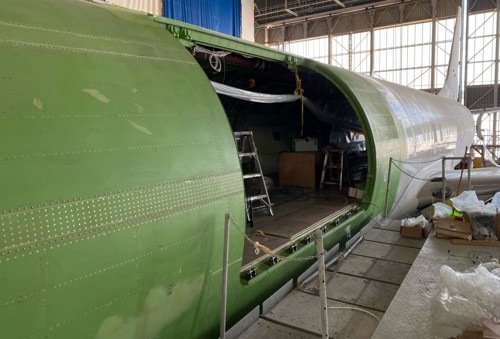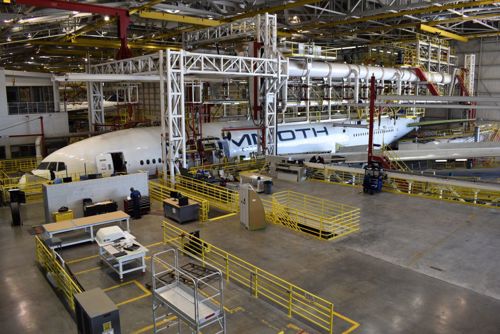
As older aircraft reach the end of their economic life, new arrivals will take their place. In March this year, Embraer launched its E-Jet Freighter programme to convert E190s and E195s, offering a replacement for turboprops and older models of Boeing 737 such as the -300.
Since its announcement, the lessor community has taken interest in the E-Jet with Nordic Aviation Capital ordering two E190s, which will be operated by Astral Aviation. Embraer is in advanced discussions with other companies and more orders will be announced soon.
Embraer says, “The full cargo conversion will extend the life of the most mature E-Jets for another 10 to 15 years, and encourage their replacement of ageing fleets, with the E1s which are more efficient, more sustainable, and quieter aircraft.”
The growth of e-commerce is increasing demand for cargo aircraft, requiring agile and decentralised deliveries, often on shorter routes, which makes the E-Jet ideal, according to Embraer.
To modify the aircraft, a new cargo door is installed in the fuselage, the interior is removed to make room for a cargo handling system, and some other upgrades to systems including avionics, fire extinguishing, and air conditioning are carried out to make it better suited to the cargo world.
Embraer says, “The advantage of Embraer’s solution is everything will be integrated with aircraft systems and manuals. No STC could offer such level of integration.”
Its flexibility makes it ideal to take over from larger operations sub-optimally deployed in terms of weight and volume, says Embraer.
It explains, “The E-Jets Freighters were designed to be fully compatible with standard pallets, allowing for smooth integration with current operational, but not necessarily optimised fleets. Also, there are under-floor cargo compartments that can be loaded with bulk cargo. The cabin is highly optimised and can be fully filled with containers or pallets.”
Compared to turboprop aircraft, the E-Jet has over 50% more volume capacity and three times the range. Its operating costs are up to 30% lower than other narrowbody aircraft.
With its volumetric capacity, the E-Jet is a suitable replacement for B737-300Fs, which are nearing the end of their lives.
Embraer says, “Boeing will naturally promote the larger 737-700 and -800 for cargo operations, although we understand that they will not be able to address the more customised and agile markets, especially for e-commerce.”

Not slowing down
The Boeing 737-800 is the most popular aircraft for conversion at Aeronautical Engineers (AEI), with five conversion centres served by 12 lines.
Founded in 1958, AEI has converted several types of aircraft over the years, and has active conversion projects for the 737-400 and -800, MD80 series, and the CRJ200.
Demand has been good this year with 12 orders for 737-800s, four 737-400s and two MD80s. AEI has a backlog of 78 737-800s and is the focus product while the others are legacy products.
The 737-800 received its STC in 2019 but they were very expensive at the time, stalling the programme, says Robert Convey, Senior Vice President – Sales and Marketing.
Boeing had received its STC to convert 737-800s a year before but was also suffering from a lack of feedstock for the same reason.
Covid kick-started the programme as suddenly the market was awash with feedstock as aircraft returned to leasing companies, who needed to put them to another use while passengers were unable to fly.
Convey says, “By mid-May (2020), airlines figured out that this is not going away and they started looking for lease returns and lessors said we better start doing something with these aircraft, and they started turning to the conversion world. Essentially a light switch went on for us and our customers directly driven by Covid. It was a pandemic driven spike and since then until today we are seeing a very steady flow of orders and aircraft coming in.”
Prices for 737-800s stayed high initially but as time went on, prices came down. They are going up again and availability has gone down as passenger services return. It ebbs and flows and prices are currently high due to strong passenger demand.
For ‘classic’ 737s, the feedstock is almost non-existent, there are more -300s than -400s but demand for -300 freighters is limited.
They are also too old, production ended in the late ‘90s so the youngest aircraft are quarter of a century old.
Demand for -400s is still there but there is no feedstock as they have all done at least 50,000 cycles, making them an unappealing prospect for conversion.
Lessors are not interested in -400s but airlines are, but finding one worth converting is near enough impossible.
Convey says, “The ones that are for sale today, we have had several customers look at them and pass, they are too corroded and cracked, too old so it does not make sense. If you are going to put $3m into conversion and another $1m into maintenance on top of whatever you buy it for, it has got to be a decent aircraft and if it is too old and long in the tooth, it’s not worth the investment.”
MD80s are still doing well but are being hindered by the availability of engine parts. With two being converted and three in the backlog, Convey predicts AEI has another year with the MD80 before it reaches the end of the road.
The CRJ200 is also nearing the end, it is a small aircraft that was mainly used for automotive charters and never had a broad operator base. It has another year, year and a half at most left in it, says Convey.
With a backlog of over 70 aircraft, AEI is fully booked this year and has a few slots for next year. AEI is taking orders for 2024 and 2025 and has plenty of slots available.
Due to cost and availability, lessors are the main clients who are willing to book slots without the ownership of the aircraft, booking 85-90% of AEI’s orders.
Airlines are finding aircraft here and there but it will be a few years before the customers are nearer 50/50 airlines and lessors, which is where Convey wants to be.
“The issue is airlines do not do slots on spec, they do it for a contract. They get a contract, get an aircraft, convert it then fly that contract. They can’t compete with the lessors who are consuming a lot of the slots. We try to hold a few slots back for operators only but from mid-2021, it has been lessors who have been consuming up to 30 slots at a time, pushing out operators as they can’t book out that far,” says Convey.
After the pandemic-fuelled boom, global cargo demand is slowing but orders for converted freighters are still coming in.
Convey says older aircraft still need replacing, so those orders have not been affected, and though orders for growth have slowed, they have not stopped and AEI are not getting cancellations.
Strong demand will continue until the end of 2023 before a levelling off in 2024, predicts Convey, who expects a sustained production rate of -800s of 50-60 a year.
“It’s not slow, we are producing just shy of 40 -800s a year right now but I expect that would get to the high 20s or low 30s within the next year and a half. It’s still a large amount of aircraft and more balanced with what demand is, and it’s a more sustainable number,” he says.

Optimal freighter
With the retirement of 747s, MD11s and DC10s, operators need to look for replacements, and that is what Mammoth Freighters is offering with its 777 conversions.
Working on 777-200LRs and 777-300ERs, they can carry more cargo than older freighters with greater fuel efficiency.
Brian McCarthy, Vice President Sales and Marketing, says, “Mammoth’s objective is to build an optimal freighter that minimises fuel burn and operating cost while enabling the customer to carry variable payload found in their operations.”
The 777-200LR will appeal more to general cargo operators, says McCarthy. It has a payload of over 100 tonnes and a density of 10.4lbs/cubic foot.
McCarthy says, “It’s about as close as your going to get to the utility of a production freighter without spending the extra hundred million dollars for a new build.”
The 777-300ER, which has a much larger feedstock, is a high density freighter, suitable for the integrator and e-commerce sectors. It has 28,739 cubic feet of volume and 7.7-8lb/cubic foot is achievable.
McCarthy says, “In a future world where every drop of fuel and cubic metre of cargo will matter, the 777 is a real leap forward in the race to retire older inefficient platforms. The 777s respond well to the urgency to improved emissions standards which are tightening by the minute as well as congested skies and route authority.”
Significant numbers of freighters, both factory built and conversions have been ordered since the start of the pandemic, leading to oversupply, but the widebody sector is less affected due to being a smaller market.
McCarthy says, “The widebody market is a little more stable because there is a metering affect with fewer conversion and STC options for any given fleet type. This metering effect of conversion slot availability and the longer range planning typically associated with widebodies flattens out the peaks and valleys of the supply and demand cycle.”
This article was published in the October issue of Air Logistics International, click here to read the digital edition and click here to subscribe.
